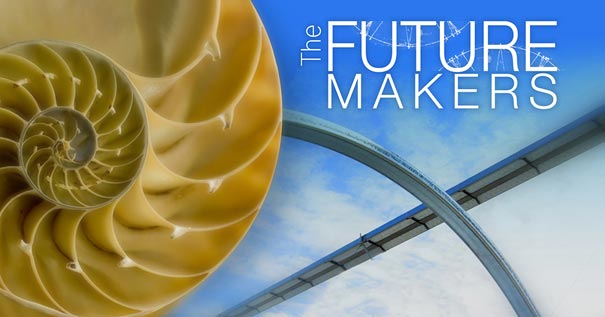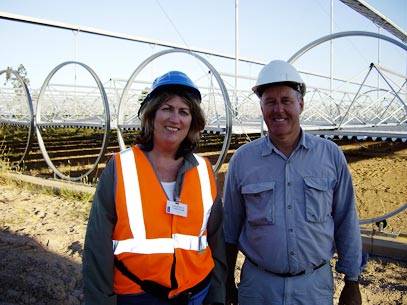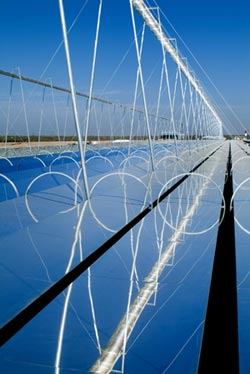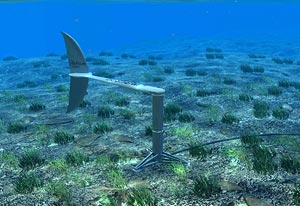
 In Conversation with Maryella Hatfield, Director of The Future Makers
In Conversation with Maryella Hatfield, Director of The Future Makers
Interviewer —
Maryella Hatfield is the director/ writer and co-producer of The Future Makers, a climate change documentary that explores the stories of eminent scientists in Australia leading the way on the world stage in renewable energy. The film was broadcast on Discovery Channel in 2008–2009 in Australia and the Asia Pacific, and continues to be screened in a number of international film festivals. Maryella spoke to Andy Marlow, a design professional and Masters of Architecture student whose key area of practice and research includes issues of sustainability.
Marlow: Would you like to explain a little bit more about the film?
Hatfield: The Future Makers looks at some of the leading renewable energy scientists in Australia to focus on some of the solutions around responses to climate change. I had this perception that a lot of the discussion around climate change and [a] lot of the environmental issues that we’re facing were getting bogged down in the problem, and I kept feeling, well, hang on, what about the solutions? What about the people who are actually working on really good ideas around sustainable design or renewable energy solutions? We aren’t hearing those voices enough and I knew from my own research that there were interesting, good people doing great things, and I thought it would be good to capture those stories and communicate them to audiences in a way that brings them to life and ‘physicalises’ these technologies and shows us how they work.
Marlow: I think the film did a very good job of that. One of the issues that came up a lot throughout the film was the role of design. You kept referring back to bio-mimicry and the potential that gives us for a future direction. Would you like to expand on that?
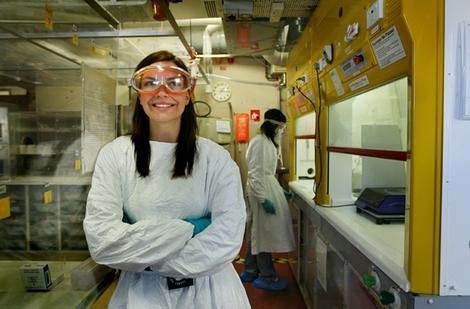 |
Hatfield: I found the concept of bio-mimicry really fascinating, really intriguing. I thought, look here we are, we’re in the middle of this problem, you know, this whole environmental challenge, whether it’s climate change or whether it’s what we’re doing to our environment in terms of natural resource exploitation and pollution and general resource management. [So] I thought, okay, we’ve created this problem through our attitude to the environment by seeing it as something that’s not particularly valuable, and I found it fascinating to think about looking at solutions and looking at nature as a source of inspiration and ideas.
The idea of bio-mimicry is very much about innovation inspired by nature. It’s about looking at how nature solves its problems and saying that’s incredibly clever and elegant and smart and sophisticated. Why don’t we learn from [this] and try and apply it to our human problems? I was really interested to look at ideas and technologies that did that.
I was fortunate to spend time in the Amazon with a woman called Janine Benyus who wrote the book Bio-mimicry: Innovation Inspired by Nature. She’s the guru of bio-mimicry and she takes people into a natural environment; she’ll take engineers, designers, architects, it might even be social policy people. She’ll take them into that environment and say, okay, let’s look at this ecosystem and let’s learn how it solves its problems and apply this to our human problems. So we had ten days or so just wandering around [the Amazon] with all these designers and engineers going, ‘hmm, how fascinating, look at how a tree solves its water problems.’ It uses its capillary action to draw water up through the roots and out to the leaves [creating] this transpiration process. You’ve got this incredibly complex and interesting way of solving problems in nature. I found her prompt and her inspiration very inspiring to me personally. [And] that’s why I was keen to look at examples in nature and [at] people who used nature to solve their problems.
When it came to thinking of examples [for The Future Makers] we decided to look at particular people like Tim Finnigan who has a company Bio Power Systems. He looked to nature for inspiration when it came to designing his wave and tidal power devices. He looked at how sharks swim through the water. How they use their tail beat to propel them through and he said, ‘why don’t we use that as inspiration to design our tidal power system?’ So he [created] these neat little underwater wind farms. They have blades with little tails on the end and the current propels them backwards and forwards, and that generates power and it goes to shore and gets fed into the grid.
The other example of bio-mimicry we looked at was the solar sailor Robert Dane’s solar sailboat where he used the insect wing as inspiration for his design for sails on [the] top of boats. These can be angled to the wind or to the sun, and you can use the sails to propel you along, using either the wind or the solar panels to collect solar power. It’s a bit like a Prius on water. So it has still uses a bit of fossil fuel but it also uses sun and wind to propel the boat. [Dane] looked at insects and how they angle their wings to the sun and to the wind and I wanted to capture that.
Then finally, we wanted to look at the idea of the industrial ecosystem or the energy ecosystem where you have different forms of technology working together in a more organic, holistic kind of way. I think it’s a really interesting model for the future, considering that we are going to need lots of good innovation and inspiration from nature to help us solve an environmental problem. For me there’s a really interesting logic there.
|
Marlow: One of the things that struck me about the film on the communications front was that you didn’t attempt to communicate the science of climate change in the sense that [the film] didn’t engage in a debate about ‘is there or is there not human-induced climate change’. I’m assuming that was a very conscious decision. Do you want to explain [that decision]?
Hatfield: It’s funny you should say that. I guess I didn’t want to get bogged down in [what] I think [has] become quite a dysfunctional ... it’s not even a debate anymore. It’s just this sort of ding-dong battle.
Marlow: Well, a debate does imply that there are two well-informed sides having an intellectual discussion.
Hatfield: That’s right. Debate does imply that, and unfortunately I think the well-informed side is not being listened to, or understood properly, and there’s a lot of muddying of the waters and, to be honest, I don’t want to get bogged down there because I think you could spend half your life trying to sort through that and explaining it to a lay audience, and I also think that’s part of the problem. Getting bogged down helps us to stay stuck and it stops us from seeing what needs to be done. That’s why I wanted to focus on solutions. But I felt also that making a film just about the science of climate change wasn’t really where I wanted to spend my time and energy. I felt, for a start, that there have already been quite a few films made about the so-called issue and impact. We’ve already seen An Inconvenient Truth, we’ve already seen The Great Global Warming Swindle, which positioned the idea that you had these sort of warring parties. But I don’t think the latter film particularly depicted the reality that most scientists agree that there is a consensus, that climate change is human-induced, and that it is a problem we’ve got to deal with. I’m interested in hearing about the vision and listening to the visionaries and being inspired because I think there’s some very exciting opportunities out there which aren’t being covered as well as [they] could be in the media. I was very interested in trying to communicate some of that.
Marlow: I must admit I found it refreshing that you didn’t engage too much. I liked the odd little bit with the guy in Far North Queensland. He made the comment [that] trees can’t absorb all the emissions, you’re going to have to do something else. So there were these little references which were obviously off-the-cuff, but which you left in there. I thought it was good to rise above and say, okay, you can tell from the nature of the film, and the way it’s put together, that we’ve accepted all this stuff that’s gone before. We don’t need to go there. If you want to go there, then you know where to look, but let’s move on.
Hatfield: We did an enormous amount of research prior to the final film. In fact, all of the interview material you see is just the tip of the iceberg. We actually have hours and hours of interview material with the people you see in the film, plus people who you don’t see. For example, we interviewed Professor Stephen Schneider who died recently. He was a very well-respected climatologist from Stanford University dedicated to explaining and communicating the science of climate change in a way that people could really understand. We could have made almost an entire film about him.
The North Queensland story was a little vignette [that aimed] to summarise, in a more cinematic way, how different scientists are trying to measure carbon dioxide in the atmosphere and responses to it.
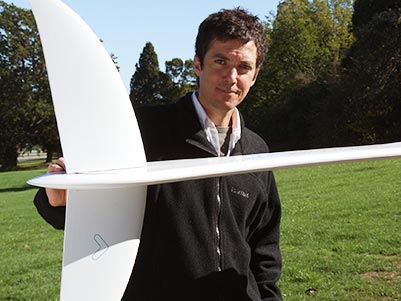 |
Marlow: You obviously have a background in media. How much is the media contributing to the current state of inaction? Is it realistic to expect them to do anything more? Are they a product of the world in which they exist, or are they the producers of the world in which we now exist?
Hatfield: I think that’s a really interesting question because so much of our world is shaped by the agenda that the media sets down and quite often we are constrained by the fact that the media has certain formats and certain restraints and constraints. Which by their very nature, by the very nature of the forms themselves, creates certain limitations and you either have to work within those if you wish to reach a wider audience, or you have to step outside those formats to reach different audiences in different ways. I think that’s what’s happening at the moment with the web: there is a fracturing of audiences. And I think it’s very interesting because we’ve got these incredible sorts of polarities and extremes. On the one hand, you have the need for a greater understanding of complex issues like climate change and science in general. [There’s] the general public’s need for a greater grasp of science, but also the [need] of the media; for journalists, economists, for people in certain areas beyond their own specialty to say we need to get our head around these other specialties and specialisations. There is this requirement to be more expert in your understanding of things and to be more respectful of expert opinion, expert knowledge.
On the other hand, you have things like Twitter – 130-characters or 140 characters, I think it is, but one sentence or thereabouts to express an idea. Now the thing is that, in spite of it being [an] incredibly constrained medium, the level of debate in the Twittersphere can be intense and extraordinary and diverse. So I think the issue of how the media defines debate and how it defines agendas is very much under challenge. I think this is [a] very interesting time to be watching these topics, whether it’s the topic of climate change, or the relationship between science and economics, or the relationship between the media and all of these things because there [are] such massive changes going on. I think there’s a huge amount of pressure on people to be different and not fall back into old patterns.
|
Marlow: You mean for the media to do things differently or for [the] general public?
Hatfield: I think it’s happening for everybody actually. I don’t think it’s any one. I think the media have come under a lot of heavy criticism recently, [for example] the Australian Federal elections in 2010. There were some very critical comments made about the media coverage of the election, and it’s interesting to see how that debate has been played out, and where it’s being played out. I think you’ll find that in social media there’s a lot of commentary about the inadequacy of the [mainstream] media in terms of responding to complex policy issues. I can’t remember who it was now but there was one journalist who wrote about the idea of the climate change issue being like the giant killer. We’ve supposedly lost one Prime Minister, one Opposition Leader. Who knows whether our latest Prime Minister is going to survive? And Howard was felled, in part, by climate change. It’s been such a thorny issue and the politicians have found it difficult to navigate this treacherous territory. So the challenge is also for the media. How do they represent the issues and the stories and the level of detail that the science requires? When you look in the blogosphere and at the invective and negativity surrounding any kind of rational discussion, [it] makes it very, very difficult to be rational and to discuss things in a smart sort of way.
Marlow: I think that, especially with new media – meaning anything other than television and newspapers – there’s a huge number of people who interact and express opinions and read other people’s opinions, but is it a case of preaching to the converted? These people are obviously reading, they’re following someone on twitter for whatever reason, they’re reading certain blogs because they obviously have some affinity to the person writing the blog. But are they really encompassing a large proportion of the population? And if not, which I guess, is my contention, how do you get to the other 80, 90, 70 or how many per cent of people who are just watching the nine o’clock or six o’clock news?
Hatfield: I think you’re right there. I think you’ve got this group of people who are very engaged to a point where you could say they’re almost completely dominating the media space in those areas. But I think it’s important not to underestimate the influence because even though something that gets tweeted over here might appear to be sort of minor, quite often the influence it has in other areas can be surprising. You might get one person tweeting something over here, but then it may be responded to by somebody like Mark Scott of the ABC, which happened recently in a particular case. By the same token, something is tweeted over here and it gets reported on SKY News, so it’s not just the ABC or public broadcaster that’s going to respond, it’s also the commercial broadcasters. So whether or not there’s going to be this thing of asymmetric power, where one tweeter can actually have a sort of disproportionate amount of influence, I think that’s an issue that’s being played out at the moment. I think we’re yet to really see how much power that’s going to have. In the old days the broadcast medium was about megaphone broadcasting or the megaphone message. [There was] the idea that it’s all completely one way. That’s been changed radically by this more interactive and more responsive way of engaging with media. I think that’s having profound influences in ways we are yet to really see.
|
|
Marlow: In terms of reaching audiences that wouldn’t normally be reached, The Future Makers was always going to have certain audiences who would have an interest in the film and who would somehow come across it and watch it, and presumably be informed and entertained by it. It’s been two years since it was released. How have you gone [about] reaching the people who wouldn’t ordinarily see this type of film?
Hatfield: Well, the thing about the film is that it was first broadcast on Discovery Channel. So it’s had about four or five broadcasts through Discovery in Australia and the Asia Pacific but, as we know, that’s a pay TV cable channel and again, it’s a very limited sort of audience, especially in Australia. However, we had a lot of enquiries, despite the fact that it just went to cable. We had a lot of people coming to us asking, ‘how can we get to see the film in a different kind of way?’ We’ve responded by saying, well, we can organise screenings for you, or you can help us organise screenings, or you can organise screenings, and we can come along and be part of it. So we’ve actually had quite a lot of screenings where we show the film and then afterwards we have a group. It could be a group of people from the film, it might be some scientists from the film who decide to stay back afterwards to answer questions with a little panel discussion, or we might have some local experts on sustainability who come along and answer questions. So the idea is to show the film but not just show the film and have everybody walk away going ‘that was all very nice’. But to actually have the film shown and then have it followed by a discussion so people in the audience can ask questions and really throw ideas around, and we’ve had lots of different types of audiences. They’ve been everything from local community groups, to corporate groups, to the Sydney Theatre Company. We had one at the Randwick Ritz (organised with local government, Randwick, Woollahra and Waverley Councils) which also involved a lot of the academics from [the] local University of New South Wales as quite a few people from the University [are] in the film. So they turned up and we also had the local climate action group and a local green business, Go Get Cars.
Another corporate screening was down at the Opera House where they had a sustainability initiative and the idea was to bring people together to energise and enthuse them about sustainability initiatives. Lend Lease were very interested, and the Australian Council of Superannuation Investors group were interested in trying to raise awareness amongst their group of investors and analysts to say, ‘look we need to get people on board with this’. So you’d be surprised at the different types of groups who are interested, and that’s what I like, in a way. To see different groups using the film because it is a neutral film in one way. It’s not very controversial, I don’t think, and it was designed that way. It was designed to be user-friendly. There’s the idea that it can actually be utilised in any kind of audience for their particular needs, and I quite like seeing people using it however they wish. School students, universities ... it’s been shown in a lot of different contexts and it’s great to see different responses from audiences and [to see] people realise that we do have options, we do have choices, we don’t just have to settle for the same old way of doing things.
About the Author
Maryella Hatfield is a filmmaker and lecturer in Media Arts Production in the School of Communication Arts at UWS. She received her degree in film and television directing from the Australian Film, Television and Radio School. She also has an Honours degree in History and Literature from the University of NSW. She worked for many years as a producer and director in the media industry prior to working at UWS. She has also taught Media and Communications at UNSW. Her PhD research explores issues surrounding media, communications and climate change.
Contact Details
Maryella Hatfield m.hatfield@uws.edu.au ; maryella@thefuturemakers.com.au
About the Interviewer
Andy Marlow is a design professional with a keen focus on issues of sustainability. He has worked both at the domestic scale and on large international projects, and he is also an active member of the Australian Institute of Architects NSW Sustainability Committee. Andy has been delivering workshops on sustainable renovations for the past four years. He is currently completing his Masters of Architecture at the University of NSW.
Contact Details
Andy Marlow andymarlowsydney@yahoo.com.au
